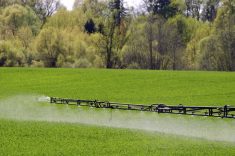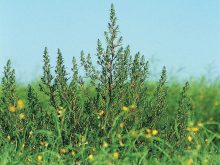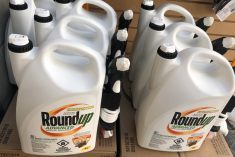The decision by an international group of cancer experts to classify the active ingredient in Roundup herbicide as “probably carcinogenic” has drawn fire from the product’s main maker.
The International Agency for Research on Cancer (IARC), a France-based arm of the World Health Organization, on Friday released its working group’s evaluations on the cancer-causing potential for glyphosate herbicide and four other organophosphate pesticides — diazinon, malathion, parathion and tetrachlorvinphos.
For glyphosate, malathion and diazinon, IARC’s 17-member group found “limited” evidence of cancer sites in humans, but “sufficient” evidence in animals for glyphosate and malathion. The group has classified all three chemicals in the agency’s Group 2A — “probably carcinogenic to humans.”
Read Also

Senft to step down as CEO of Seeds Canada
Barry Senft, the founding CEO of the five-year-old Seeds Canada organization is stepping down as of January 2026.
Parathion and tetrachlorvinphos, meanwhile, were placed in Group 2B — “possibly” carcinogenic.
Monsanto — the company that first brought broad-spectrum glyphosate to market under the Roundup name in 1974, followed by Roundup Ready crops starting in 1996 — said Friday the agency’s report offers no new research or data, but instead relies on certain studies while disregarding others.
The evaluation of diazinon, IARC said, is based on “strong mechanistic evidence” — that is, evidence based on the product’s physical processes. For glyphosate and malathion, meanwhile, “the mechanistic evidence provided independent support of the 2A classification based on evidence of carcinogenicity in humans and experimental animals.”
The evidence in humans, IARC said in a release, is from “studies of exposures, mostly agricultural” in the U.S., Canada and Sweden published since 2001, and “convincing evidence that glyphosate also can cause cancer in laboratory animals.”
The IARC group noted glyphosate now has the highest production volumes of all herbicides, and its use has risen “sharply” with the development of genetically modified glyphosate-resistant crops. The chemical, they said, “has been detected in air during spraying, in water, and in food.”
In humans, the group said, case-control studies of occupational exposure in the U.S., Canada and Sweden reported “increased risks for non-Hodgkin lymphoma that persisted after adjustment for other pesticides.”
In male mice, IARC said, glyphosate “induced a positive trend in the incidence of a rare tumour, renal tubule carcinoma” while a second study reported “a positive trend for haemangiosarcoma in male mice.” (Haemangiosarcoma is a cancer of the blood vessels, found mainly in dogs.)
Glyphosate, IARC said, also “increased pancreatic islet-cell adenoma (tumours) in male rats in two studies” and a glyphosate formulation “promoted skin tumours in an initiation-promotion study in mice.”
The group said the chemical “has been detected in the blood and urine of agricultural workers, indicating absorption” and that the detection of aminomethylphosphoric acid (AMPA) — a chemical formed when glyphosate is degraded by soil microbes — suggests humans’ intestinal microbes are metabolizing the product.
The group’s review also said glyphosate and glyphosate formulations have induced “DNA and chromosomal damage” in mammals as well as in human and animal cells in vitro, and cited a study reporting increases in blood markers of “chromosomal damage” in residents of several communities after spraying of glyphosate formulations.
“Disregarded”
In a separate statement Friday, Monsanto’s vice-president for global regulatory affairs, Philip Miller, called out the IARC report for excluding “the most relevant, scientific data” from the studies the group mined for its conclusions.
“No new research or data… was used” in the IARC report, he said, and “there is no link between glyphosate and an increase in cancer when the full data set is included in a rigorous review.”
Monsanto, Miller said, has put out an “urgent request for appropriate (WHO) personnel” to meet with members of the world’s glyphosate task forces and “other regulatory agencies” to account for the studies used in the IARC analysis — “and, equally as important, to account for those scientific studies that were disregarded.
“We don’t know how IARC could reach a conclusion that is such a dramatic departure from the conclusion reached by all regulatory agencies around the globe,” he said.
Glyphosate taskforces in both the U.S. and European Union have sided with Monsanto in its “disagreement” with the IARC’s classification, the company said, and noted each of the studies considered by IARC has already been reviewed and considered by regulators.
The German government, Monsanto said, was the most recent body to review the studies, on behalf of the EU.
IARC’s classification, the company said, is “inconsistent with the numerous multi-year, comprehensive assessments conducted by hundreds of scientists from countries worldwide who are responsible for ensuring public safety.”
The agency’s classification also “does not establish a link between glyphosate and an increase in cancer,” Monsanto said, adding it’s important to put the agency’s classifications into perspective.
IARC, the company said, has previously classified “numerous everyday items” in its Group 2, “including coffee, cellphones, aloe vera extract and pickled vegetables, as well as professions such as a barber and fry cook.”
IARC’s Group 2 is divided into Group 2A (“probably carcinogenic”) and Group 2B (“possibly carcinogenic”). The two terms, IARC said, have no “quantitative significance,” but by its definition, “probably” signifies a “higher level of evidence” than “possibly.”
By comparison, a product in IARC’s Group 1 is classified as “carcinogenic to humans,” with “sufficient evidence of carcinogenicity.”
Among the other products in the IARC report, malathion is still registered for use in Canada, but was subject to new “risk reduction” measures after a Health Canada re-evaluation in 2012. Parathion’s use has been discontinued in Canada, the U.S. and the EU since 2003.
Diazinon is being phased out in Canada for most uses by the end of 2016 other than livestock ear tags and soil drenches, due to “health and environmental risk concerns” after a Health Canada re-evaluation in 2013.
Tetrachlorvinphos, a pesticide also used mainly in products such as livestock ear tags and pet collars, is still registered for those non-food uses in Canada after a 2004 re-evaluation. — AGCanada.com Network















